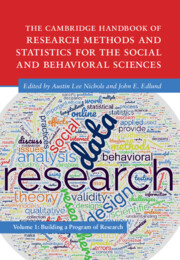 The Cambridge Handbook of Research Methods and Statistics for the Social and Behavioral Sciences
The Cambridge Handbook of Research Methods and Statistics for the Social and Behavioral Sciences Book contents
- The Cambridge Handbook of Research Methods and Statistics for the Social and Behavioral Sciences
- Cambridge Handbooks in Psychology
- The Cambridge Handbook of Research Methods and Statistics for the Social and Behavioral Sciences
- Copyright page
- Dedication
- Contents
- Figures
- Tables
- Contributors
- Preface
- Part I From Idea to Reality: The Basics of Research
- Part II The Building Blocks of a Study
- Part III Data Collection
- Part IV Statistical Approaches
- Part V Tips for a Successful Research Career
- 29 Designing a Line of Research
- 30 Successfully Publishing Research in the Social and Behavioral Sciences
- 31 Presenting Your Research
- 32 Building Fruitful Collaborations
- 33 Performing a Good Peer Review
- 34 Handling Submitted Manuscripts: As Editor and Author
- 35 Grant Writing Basics
- 36 Teaching Research Methods and Statistics
- 37 Working Outside Academia
- Index
- References
37 - Working Outside Academia
from Part V - Tips for a Successful Research Career
Published online by Cambridge University Press: 25 May 2023
- The Cambridge Handbook of Research Methods and Statistics for the Social and Behavioral Sciences
- Cambridge Handbooks in Psychology
- The Cambridge Handbook of Research Methods and Statistics for the Social and Behavioral Sciences
- Copyright page
- Dedication
- Contents
- Figures
- Tables
- Contributors
- Preface
- Part I From Idea to Reality: The Basics of Research
- Part II The Building Blocks of a Study
- Part III Data Collection
- Part IV Statistical Approaches
- Part V Tips for a Successful Research Career
- 29 Designing a Line of Research
- 30 Successfully Publishing Research in the Social and Behavioral Sciences
- 31 Presenting Your Research
- 32 Building Fruitful Collaborations
- 33 Performing a Good Peer Review
- 34 Handling Submitted Manuscripts: As Editor and Author
- 35 Grant Writing Basics
- 36 Teaching Research Methods and Statistics
- 37 Working Outside Academia
- Index
- References
Summary
Working in applied settings presents unique challenges and complexities with respect to research. Researchers have often commented on the scientist–practitioner divide, but there is a lack of information about the specific challenges and constraints of doing applied work that may contribute to this divide. As a group of applied social and behavioral scientists, we discuss what individuals should know, understand, and expect regarding the work practitioners conduct in applied settings. We describe the challenges of applied work as they relate to some topics covered earlier in this volume and identify other unique aspects of applied work. We conclude by discussing how an individual can approach deciding whether applied work is a fit with one’s interests.
- Type
- Chapter
- Information
- The Cambridge Handbook of Research Methods and Statistics for the Social and Behavioral SciencesVolume 1: Building a Program of Research, pp. 793 - 816Publisher: Cambridge University PressPrint publication year: 2023
